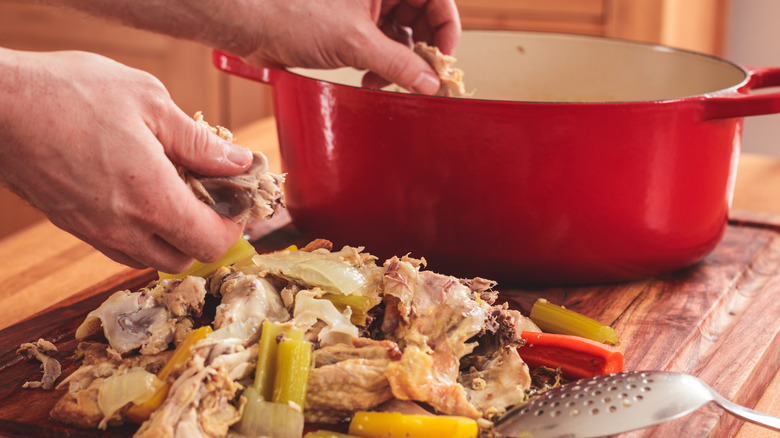The Wishbone Trick To Easily Free Rotisserie Chicken Breasts
Rotisserie chicken can be the key ingredient to a simple dinner any night of the week. They're easy to grab straight from the hot deli section; all that you need is some prep once you get the chicken home.
But removing and deboning the meat, especially if the bird is a little overcooked, can be a frustrating task. Rather than chopping with a knife or flaking the chicken into tiny pieces to get it off the bones, there's an easier way: removing the wishbone. By taking out this essential part, it becomes a straightforward task to break down the poultry. You can also make things even easier by buying a juicy bird — just pick the heaviest rotisserie chicken available.
To remove the wishbone, reach into the chicken cavity (after ensuring that the bird isn't hot enough to burn you) and feel for the small bone in the area between the breasts. Pull it out and either set it aside or split it with a friend to see who gets to make a wish.
Then separate the wings and legs to give you better access to the breast meat. The final step is to remove the chicken breasts from the bone, with the easiest way being to use your hands to pull it off. When it's all done, you should have several whole pieces of rotisserie chicken to use in a variety of recipes.
The best way to use a rotisserie chicken carcass
Once you've broken down your rotisserie chicken, don't throw away that carcass. The poultry bones, skin, and drippings can still be cooked with after the meat is removed. A popular use for rotisserie leftovers is to cook everything down into a flavorful stock, and it works great as a base for soups and stew. Simply put the carcass in a pot, cover it with water, toss in an onion and a few carrots (along with any desired herbs), and give it a few hours to simmer on low. Strain out the carcass and vegetables through a mesh colander (line it with cheesecloth for an even clearer final product) and the stock is ready to use.
The rotisserie chicken stock is delicious in dishes like chicken noodle soup or a steaming bowl of chicken congee. But beyond soup, a splash of stock is welcome when cooking grains, mixing up a sauce, or thinning out mashed potatoes. If you're not planning on using the stock any time soon, you can concentrate it for storage. After straining everything, continue to simmer it until it is reduced to ¼ of its original volume. This concentrated stock can then be poured into an ice cube tray and frozen for future cooking.
How to use rotisserie chicken in a meal
Rotisserie chicken can be substituted in most poultry-based dishes while saving you time. Just keep in mind that using it may alter cooking durations and the amount of salt needed.
If you're looking for quick and simple, serving cuts of rotisserie chicken with a side or two is an easy dinner. Taste test a piece of the rotisserie chicken skin to see how well-seasoned it is. Based on the results, try adding a sprinkling of your favorite all-purpose seasoning or get more regional flavor with a dash of cajun spices or Italian herbs. Consider using low- or no-sodium blend varieties to avoid an overly salty chicken.
For shredded or sliced rotisserie chicken, it can be transformed into a wide range of dishes from pad see-ew to shredded chicken hash. Be sure to add the meat toward the end of the cooking process since putting it in the beginning may lead to it drying out. If you're worried about that, use it in a more saucy dish such as chicken curry, white chili, or chicken and dumplings.
The final (and ultimately easiest) way to use rotisserie chicken is making a no-cook meal. Avoid heating up the kitchen and instead use the already-cooked delight to create vibrant dishes like chicken salad-stuffed avocados or chicken lettuce wraps. Cold chicken is also delicious tucked in a sandwich or tossed with a salad.



